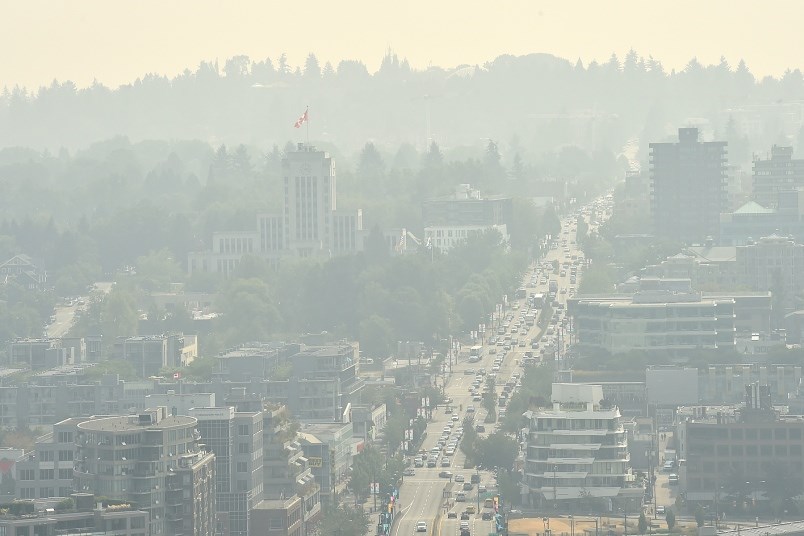Wildfire smoke and extreme heat are combining to create a lethal cocktail of environmental conditions that multiply the risk of death in Metro Vancouver, a new study has found.
The research, published in the scientific journal npj Clean Air earlier this month, found days dominated by hot temperatures and smoky skies combine to raise the risk of death across the region by 7.9 per cent.
Sarah Henderson, senior author and scientific director of the BC Centre for Disease Control’s Environmental Health Services, said the research comes as B.C. saw an uptick in smoky, hot days over the past two decades — a trend that's only expected to accelerate with climate change.
“Statistically speaking, we see this significant impact,” said Henderson.
The researchers tracked more than 21,000 deaths between 2010 and 2022 using data from the B.C. Vital Statistics Agency database. They also used models and direct measurements from satellite imaging and ground-based sensors to analyze temperature records and PM2.5 concentrations — fine particulate matter 2.5 micrometres across or smaller that can be inhaled into the lungs.
Broken down by postal code in the Vancouver region, the data focused on “community deaths.” That’s because past research had shown deaths outside hospitals and long-term care homes were more strongly associated with smoky, hot conditions — likely due to access to medical care at the facilities, as well as better air filtration and air conditioning requirements, the study notes.
“This study clearly shows impacts of extreme heat, and also PM2.5 on mortality in greater Vancouver…” said Michael Brauer, a professor at the University of British Columbia’s School of Population and Public Health.
Brauer, who wasn’t involved in the research, said in a warming climate, the results reinforce a need to continue reducing exposure to air pollution while also helping people manage extreme heat.
Results show curious relationship between smoke and heat
Henderson said the combination of smoke and heat mean the human body is trying to maintain its core temperature while copying to fight inflammation caused by smoke exposure.
“These two things come together at the same time — you've got your lungs fighting with the smoke, and you got your heart fighting with the temperature,” she said. “It’s not surprising that they would stack up to be more harmful than smoke alone or hot weather alone.”
The results suggest a complicated relationship between exposure to wildfire smoke and extreme heat. Rising temperatures were found to be directly associated with risk of death. Increasingly smoky conditions, on the other hand, were found to climb quickly at first and then levels off when PM2.5 concentrations hit moderate levels of 12 to 14 micrograms per square metre.
Henderson said the results align with other studies in California and Washington State where past research has shown exposure to moderate levels of PM2.5 lead to some of the worst health outcomes, whereas severe levels of wildfire smoke see a slight decline in mortality.
Some experts hypothesize the drop off in excess mortality occurs because the worst air quality levels push people to finally take action to protect themselves, according to Henderson. For some people, however, data suggests that may be too late.
“People start paying a lot of attention to smoke and its health risks when it's very, very smoky outside, when we see those orange skies and those extreme air quality impacts,” said Henderson.
“But what this study is telling us is we actually see a significant amount of risk at the concentrations that people might not even notice.”
National regulatory gaps remains
The study period included the summer of 2021, when a record heat dome sat over B.C., setting temperature records, straining the province's emergency response services and leading to the death of at least 619 people.
Later research found those most heavily affected during that event were people with schizophrenia, an illness that can make it hard for people to recognize how they are feeling. Anti-psychotic medications prescribed to those with schizophrenia can also impede the body’s thermoregulation.
Other populations that faced increased risk from extreme heat included those living in poverty, older adults with underlying heart conditions, and people with lung diseases. A later report from the BC Coroners Service said protecting people from future heat waves would require a combination of mechanical cooling and expanding urban tree canopies, among other changes.
In response, some municipalities have changed their bylaws. But Henderson said Canada still lacks national indoor air quality standards for PM2.5 as well as rules that require landlords to maintain temperatures below a maximum of 26 C — a key threshold beyond which the human body faces elevated health risks.
“We're going to have more hot and smoky days,” she said. “This paper provides evidence that all of those things carry risk, and when we combine them, they carry sort of a multiplicative risk.”



